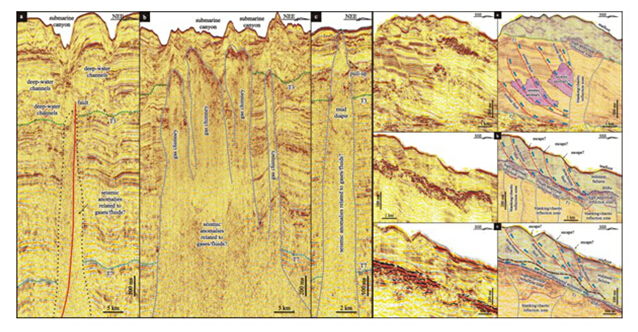Migration of gas-bearing fluids is the key factor controlling the occurrence and formation of marine hydrates. Cooperating with Guangzhou Marine Geological Survey (GMGS), Ming Su,Rui Yang and ShaohuaQiaoin the Key Laboratory of Gas Hydrate, Guangzhou Institute of Energy Conversation carried out research on gas hydrate in the Shenhu Area. Research contents included identifying and describing of migrating pathways of gas-bearing fluid, geophysical response and qualitative analysis of migration efficiency.
On one hand, vertical and lateral migrating pathways were identified in the study area (Fig. 1). Gas chimneys and associated faults (micro-fractures) were the major pathways in drilling area, and geophysical processing technologies (amplitude, AVO and frequency et al.)revealed the abnormal geophysical response of gas-bearing fluid migrations (Fig. 2).It was the combination of geological interpretation and geophysical anomaly identification that confirmthe existence of obvious migration characteristic and geologic record in drilling sites, and accumulation of free gas below the bottom simulating reflectors (BSRs). On the other hand, some comparisons in types and efficiencies of migrating pathways between the drilling area and the LW3-1 well area were conducted. Researchers suggested that the migration efficiency of “large-scale faults and diapirs” in the LW3-1 well areawas better than“gas chimneys and associated faults” in drilling area.
These research achievements and progresses in gas-bearing fluids migrating in the Shenhu Area will help to reveal the distribution regularities and formation mechanisms of gas hydrate, and provide reference for further hydrate exploration in the northern South China Sea.
Research results above have been accepted and published by ActaGeoloicalSinica (Chinese Edition), Natural Gas Industry, Marine Geophysical Researches and ActaGeoloicalSinica (English Edition).

Fig. 1 Vertical and lateral migration pathways of gas-bearing fluids in the Shenhu Area

Fig. 2 Geophysical response of gas-bearing fluids migration at Site SH2 in the Shenhu Area